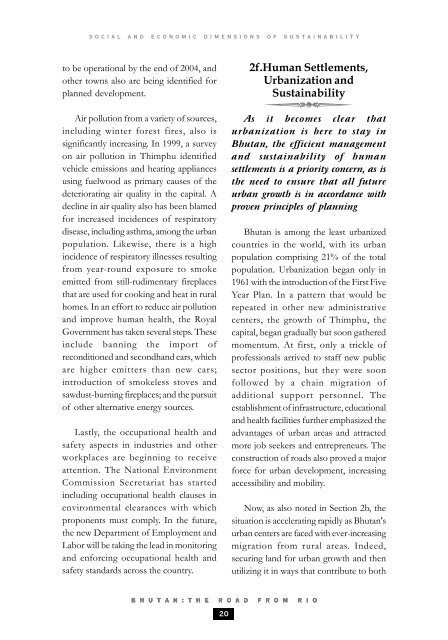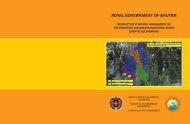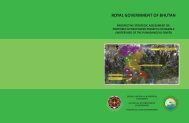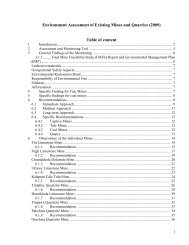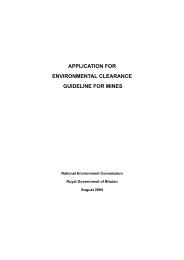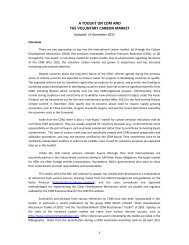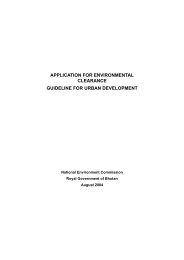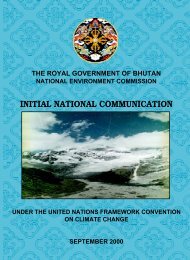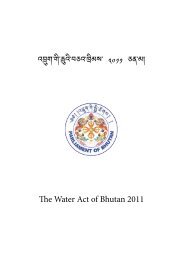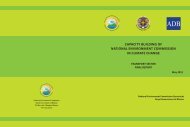Bhutan Road from Rio - National Environment Commission
Bhutan Road from Rio - National Environment Commission
Bhutan Road from Rio - National Environment Commission
Create successful ePaper yourself
Turn your PDF publications into a flip-book with our unique Google optimized e-Paper software.
SOCIAL AND ECONOMIC DIMENSIONS OF SUSTAINABILITYto be operational by the end of 2004, andother towns also are being identified forplanned development.2f.Human Settlements,Urbanization andSustainabilityAir pollution <strong>from</strong> a variety of sources,including winter forest fires, also issignificantly increasing. In 1999, a surveyon air pollution in Thimphu identifiedvehicle emissions and heating appliancesusing fuelwood as primary causes of thedeteriorating air quality in the capital. Adecline in air quality also has been blamedfor increased incidences of respiratorydisease, including asthma, among the urbanpopulation. Likewise, there is a highincidence of respiratory illnesses resulting<strong>from</strong> year-round exposure to smokeemitted <strong>from</strong> still-rudimentary fireplacesthat are used for cooking and heat in ruralhomes. In an effort to reduce air pollutionand improve human health, the RoyalGovernment has taken several steps. Theseinclude banning the import ofreconditioned and secondhand cars, whichare higher emitters than new cars;introduction of smokeless stoves andsawdust-burning fireplaces; and the pursuitof other alternative energy sources.Lastly, the occupational health andsafety aspects in industries and otherworkplaces are beginning to receiveattention. The <strong>National</strong> <strong>Environment</strong><strong>Commission</strong> Secretariat has startedincluding occupational health clauses inenvironmental clearances with whichproponents must comply. In the future,the new Department of Employment andLabor will be taking the lead in monitoringand enforcing occupational health andsafety standards across the country.As it becomes clear thaturbanization is here to stay in<strong>Bhutan</strong>, the efficient managementand sustainability of humansettlements is a priority concern, as isthe need to ensure that all futureurban growth is in accordance withproven principles of planning<strong>Bhutan</strong> is among the least urbanizedcountries in the world, with its urbanpopulation comprising 21% of the totalpopulation. Urbanization began only in1961 with the introduction of the First FiveYear Plan. In a pattern that would berepeated in other new administrativecenters, the growth of Thimphu, thecapital, began gradually but soon gatheredmomentum. At first, only a trickle ofprofessionals arrived to staff new publicsector positions, but they were soonfollowed by a chain migration ofadditional support personnel. Theestablishment of infrastructure, educationaland health facilities further emphasized theadvantages of urban areas and attractedmore job seekers and entrepreneurs. Theconstruction of roads also proved a majorforce for urban development, increasingaccessibility and mobility.Now, as also noted in Section 2b, thesituation is accelerating rapidly as <strong>Bhutan</strong>'surban centers are faced with ever-increasingmigration <strong>from</strong> rural areas. Indeed,securing land for urban growth and thenutilizing it in ways that contribute to bothB H U T A N : T H E R O A D F R O M R I O20


